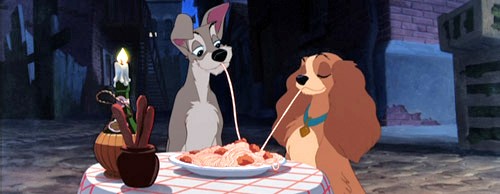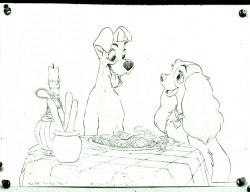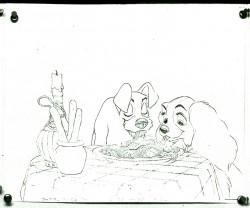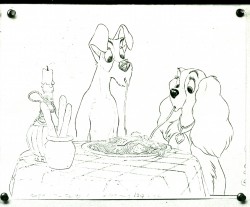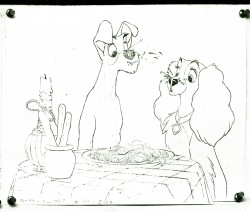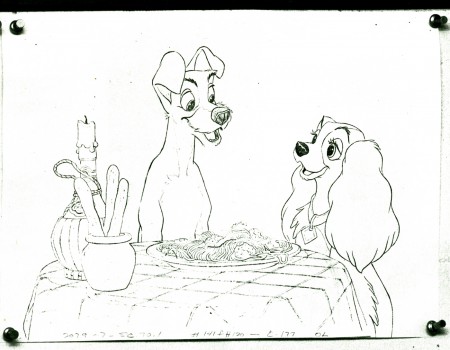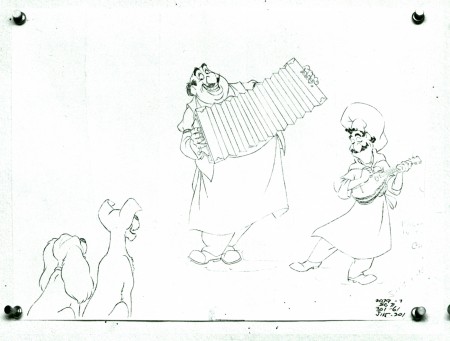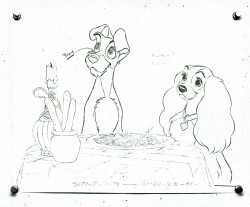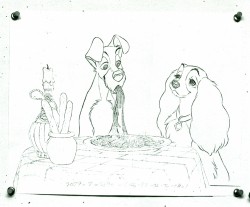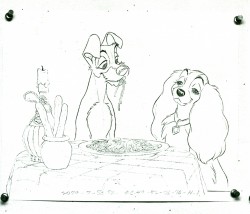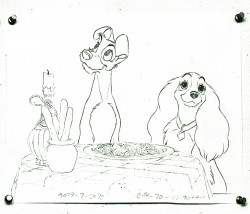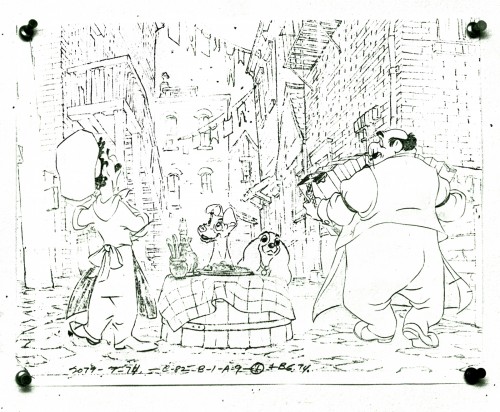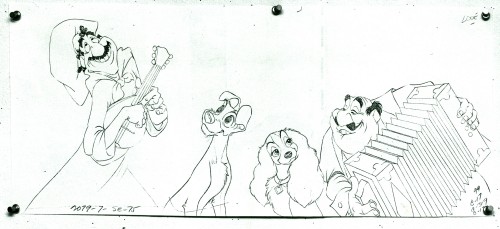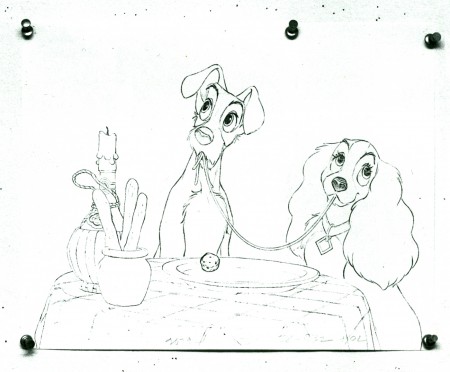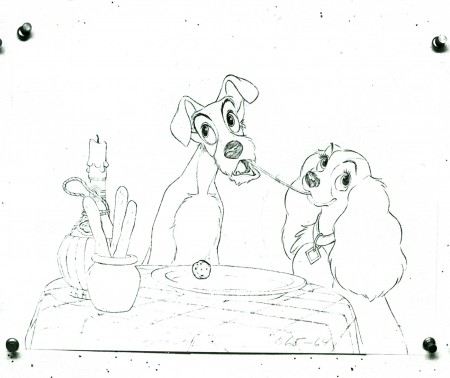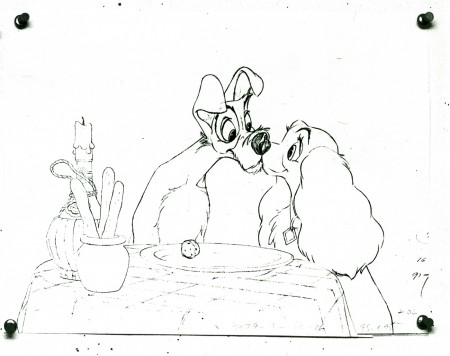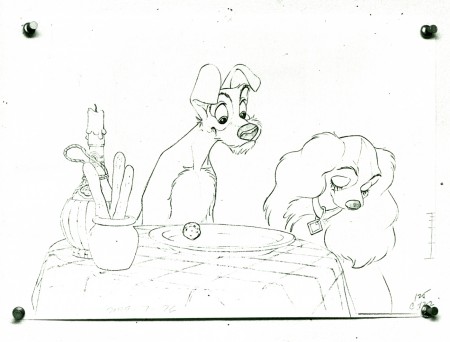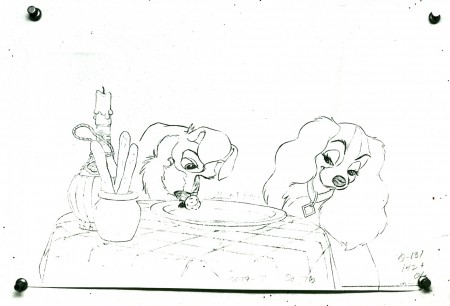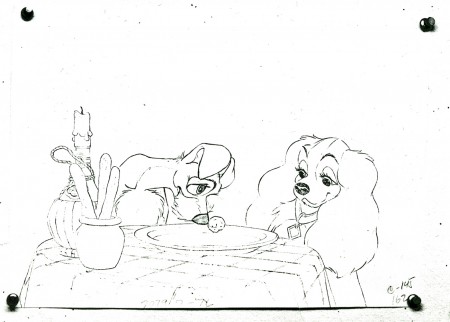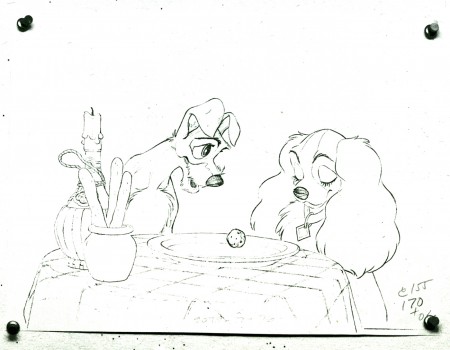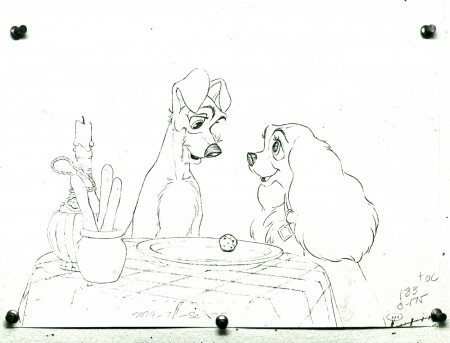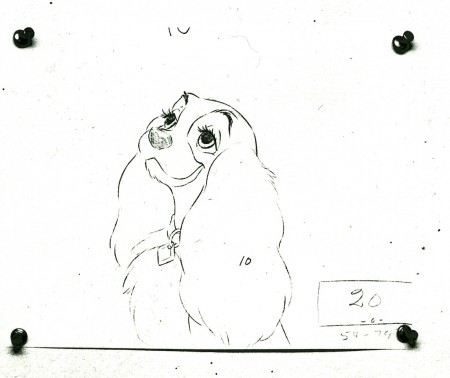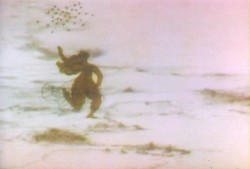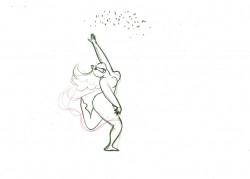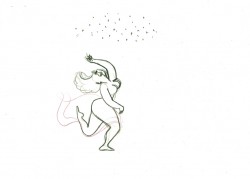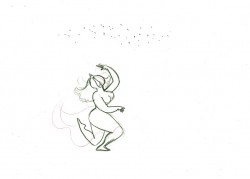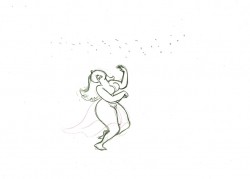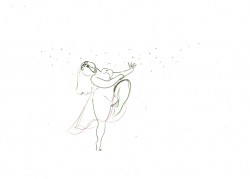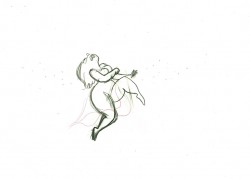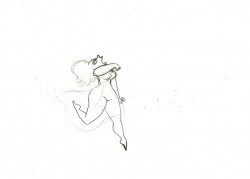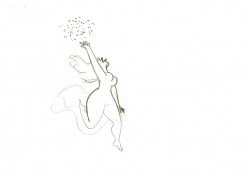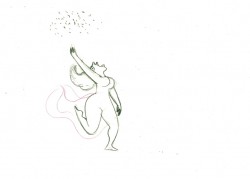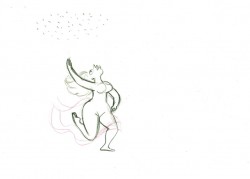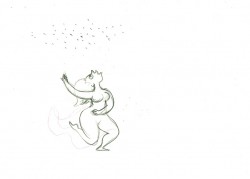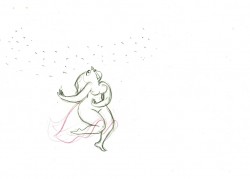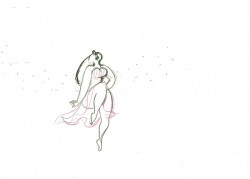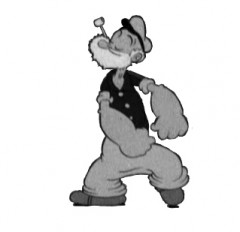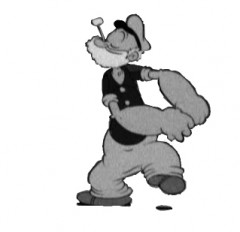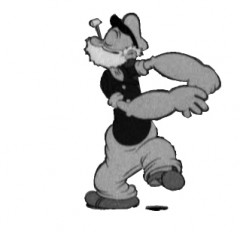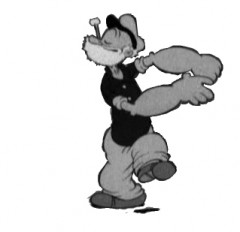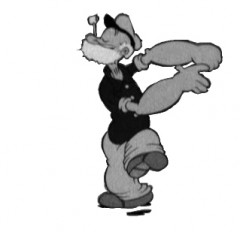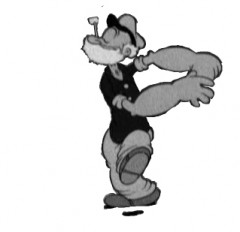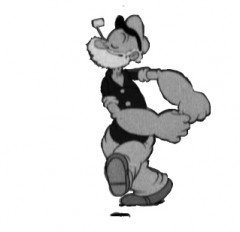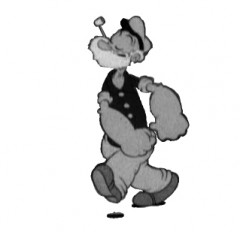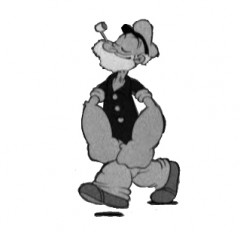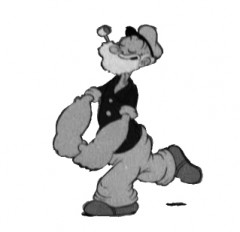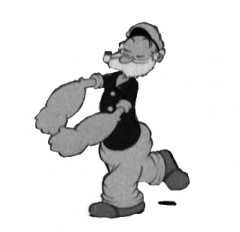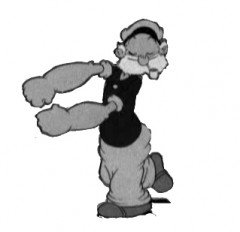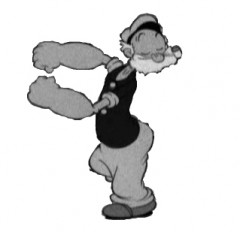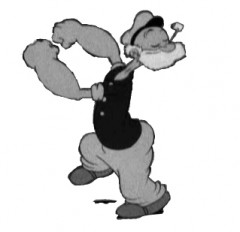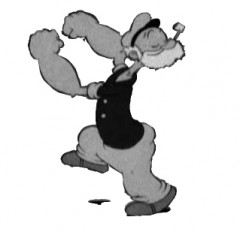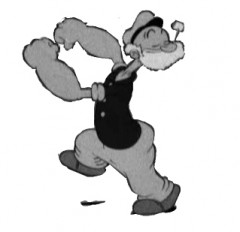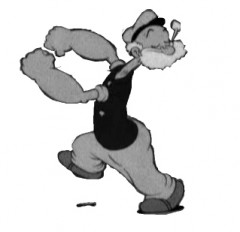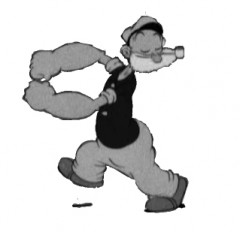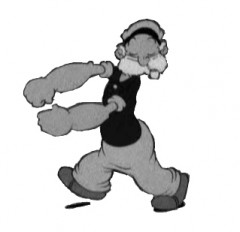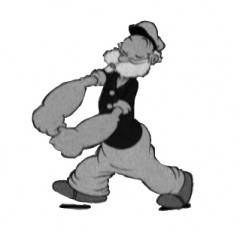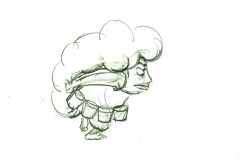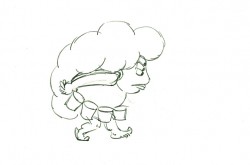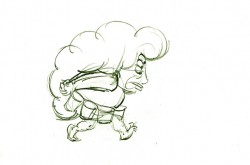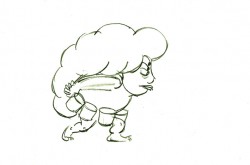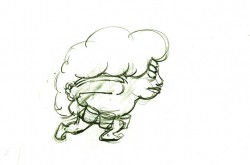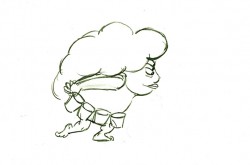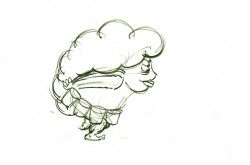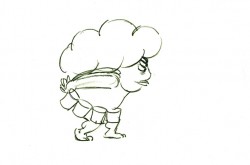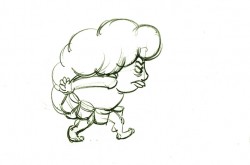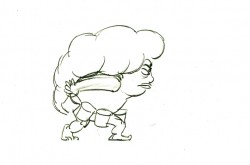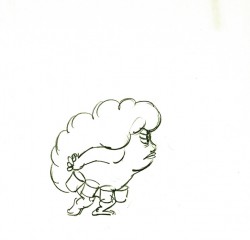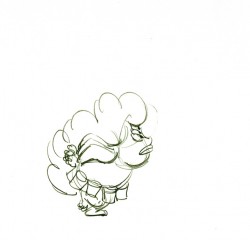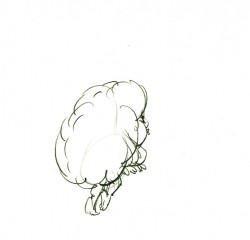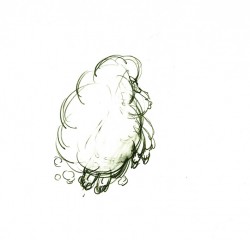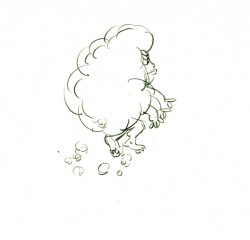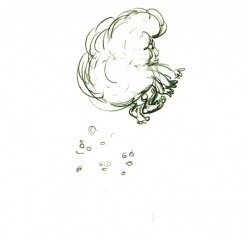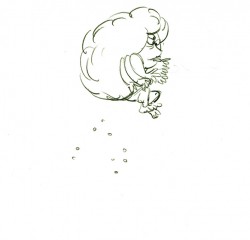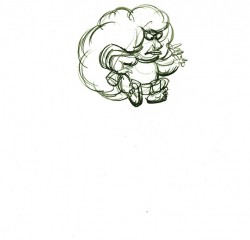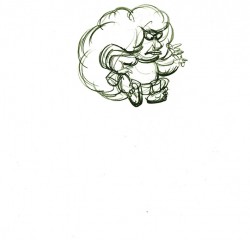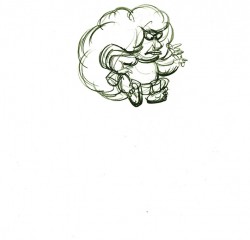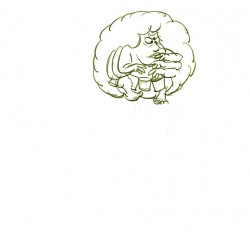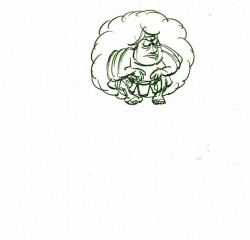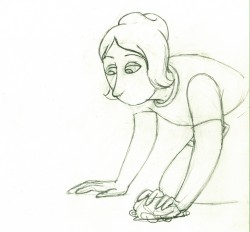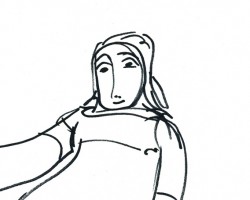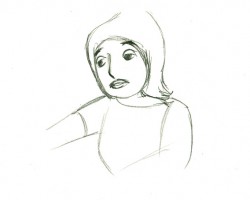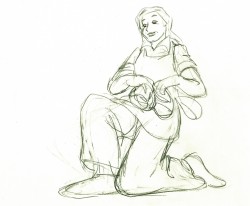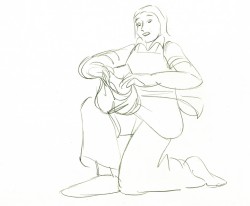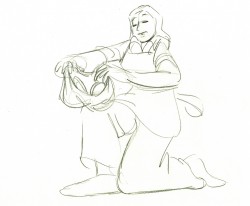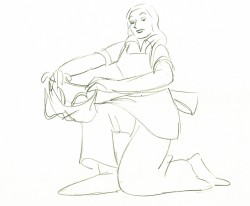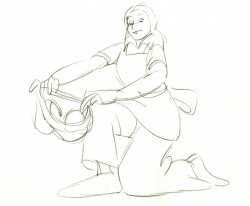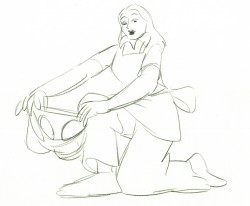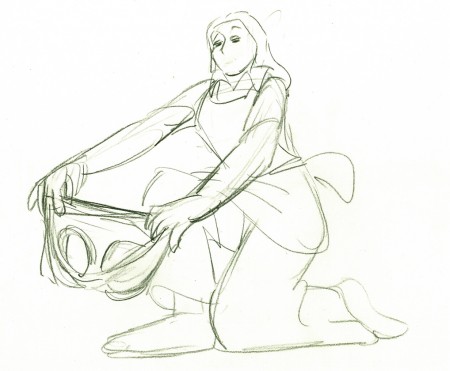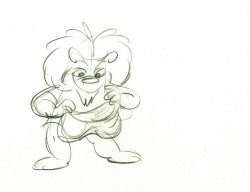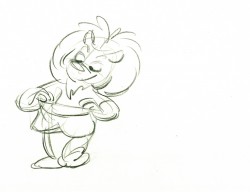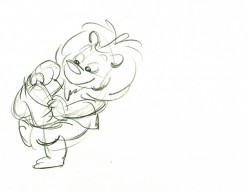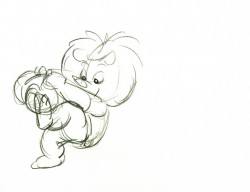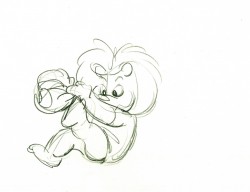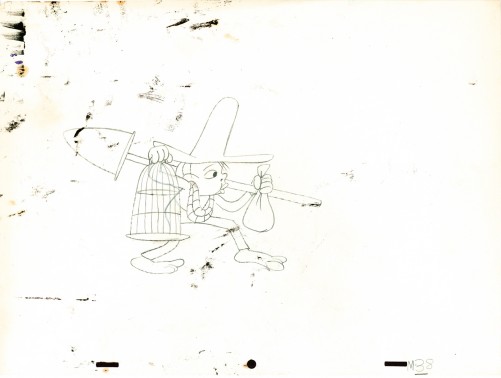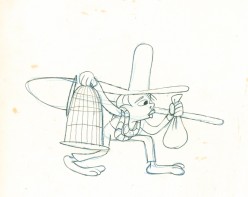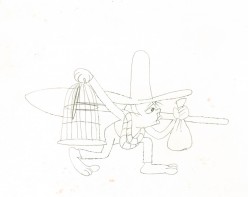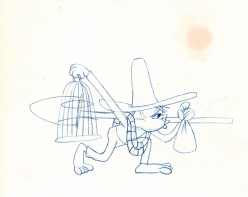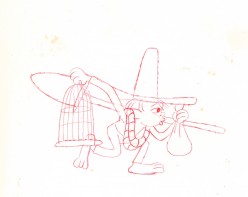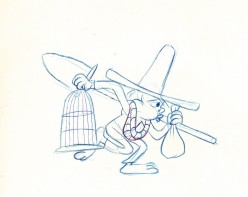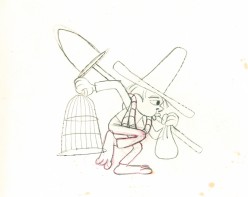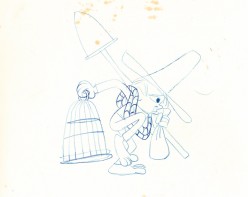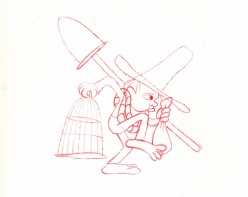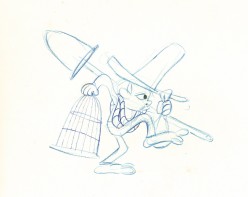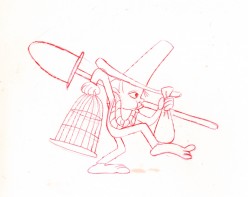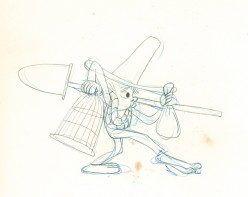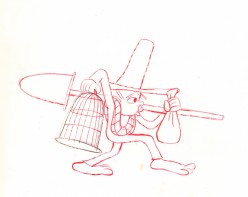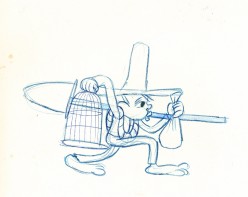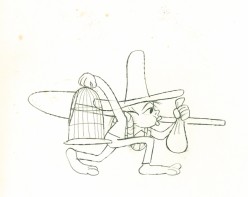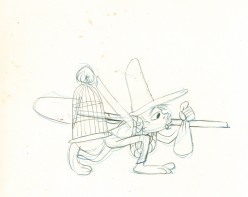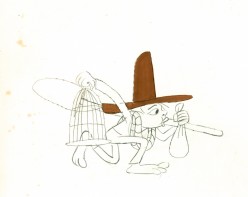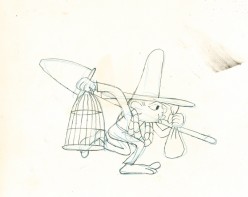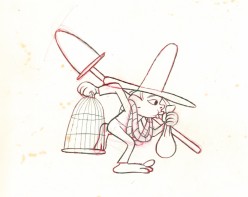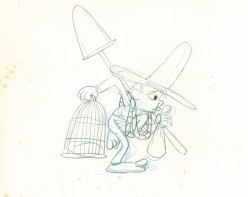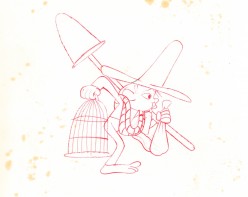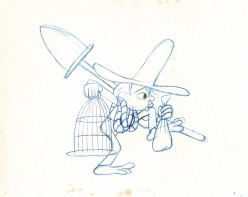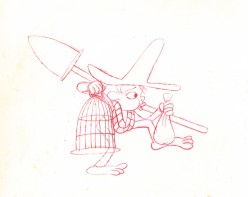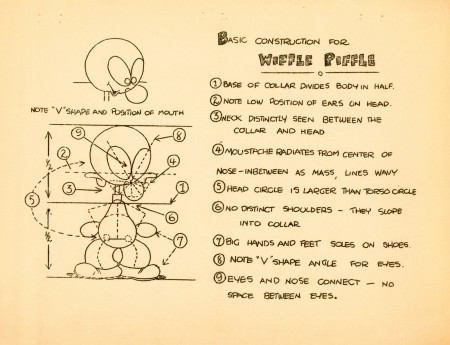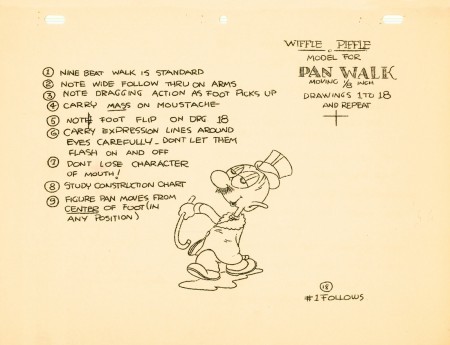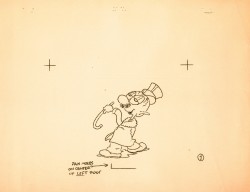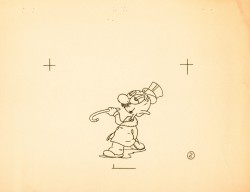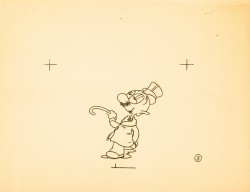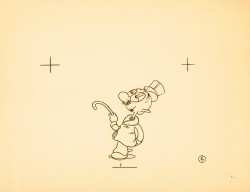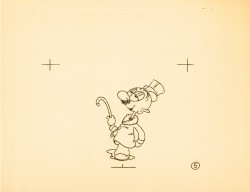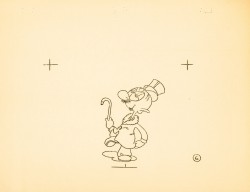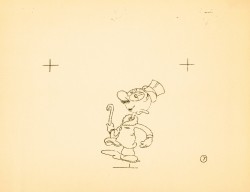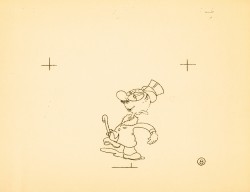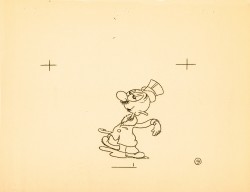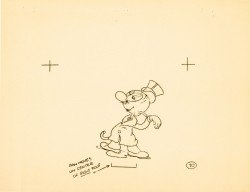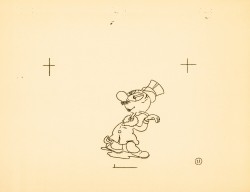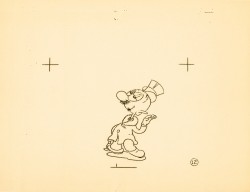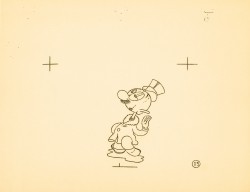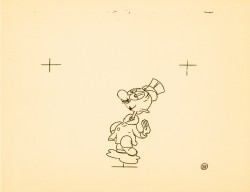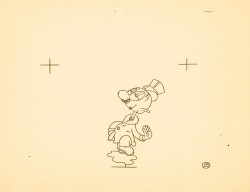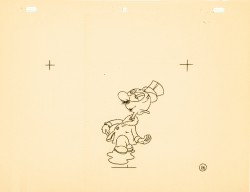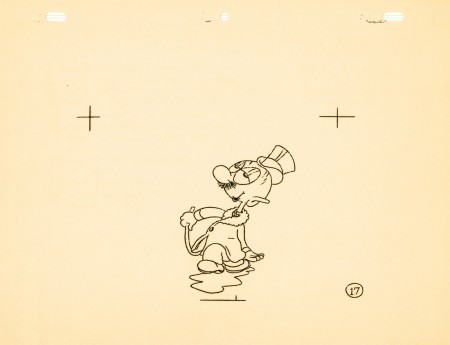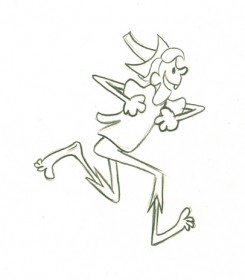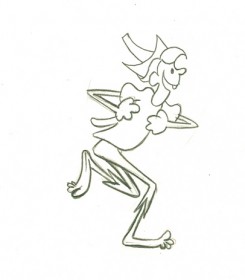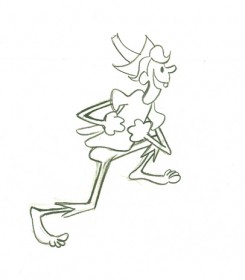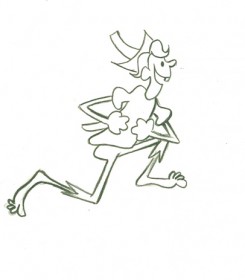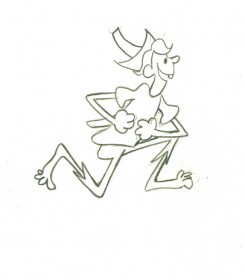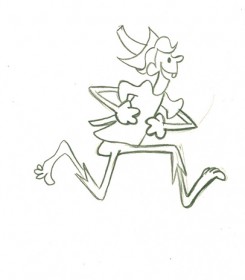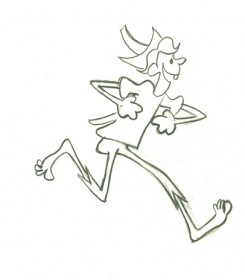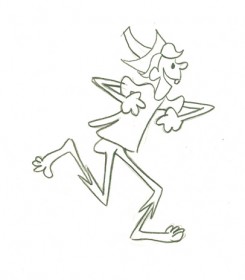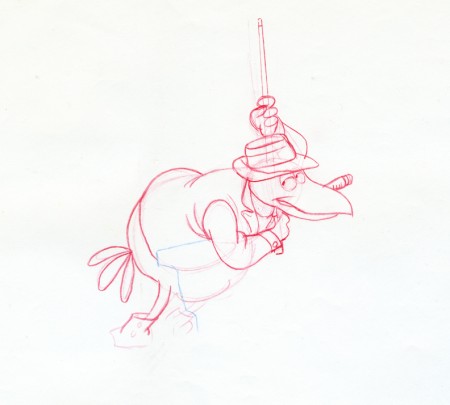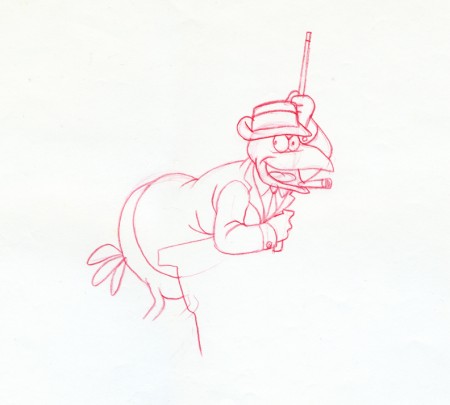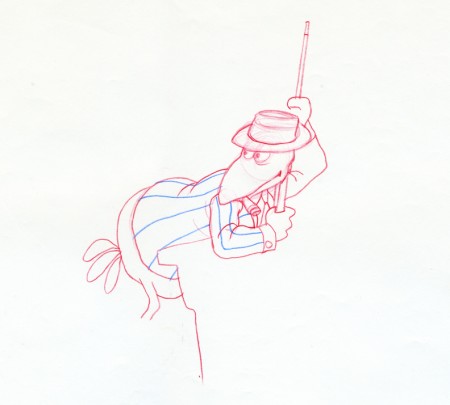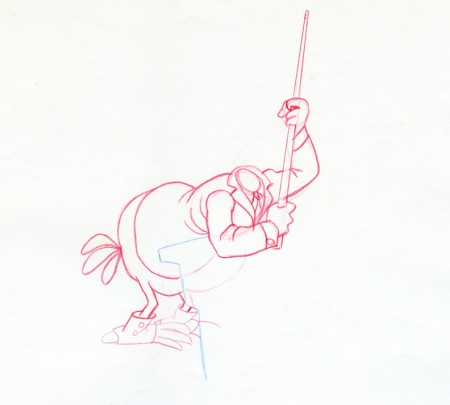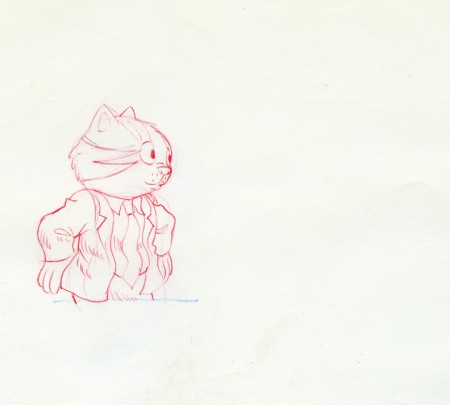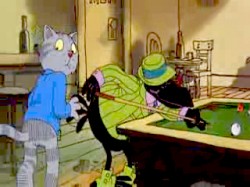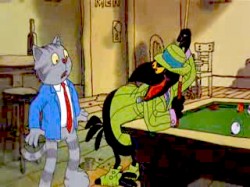Category ArchiveAnimation
Animation &Animation Artifacts 21 Apr 2009 06:35 am
L&T Meatballs
- Here’s some photographed drawings from The Lady & The Tramp meatball sequence.
These are taken from a photostat I have which was prepared for some book publication.
I don’t know if it ever made it to the book, but the drawings are too sterling to ignore.
I believe Frank Thomas animated the dogs and John Lounsbery the humans, and there are frame grabs of this sequence in John Canemaker‘s book, Disney’s Nine Old Men.
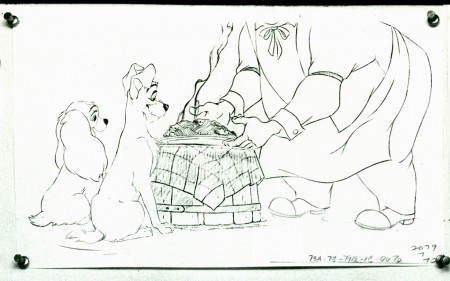
(Click on any image to enlarge.)
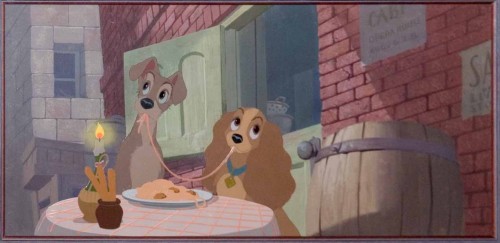
Here’s a beautiful cel set-up from Bob Cowan‘s collection.
Though it’s obvious the background is from another scene,
there’s an odd connection between the two that works for me.
Just another gem found on his great art blog.
Animation &Hubley 15 Apr 2009 07:44 am
Hub Eyes
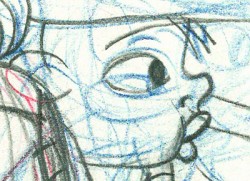 - It was 1973, and I was happily – I can’t tell you how happily – ensconced in the Hubley studio working on Letterman, a new series for an upcoming CTW show, The Electric Company.
- It was 1973, and I was happily – I can’t tell you how happily – ensconced in the Hubley studio working on Letterman, a new series for an upcoming CTW show, The Electric Company.
It was my first animation job. I inked it all (directly from animator roughs), I assisted & inbetweened it all, and I animated odd scenes including all the title sequences. I was a novice, and I was doing it all. Excited and happy is all I can remember.
I was alone one morning in the small room wherein I worked. I made a habit of getting into work before anyone and leaving after everyone. I wanted to make sure I was indispensible.
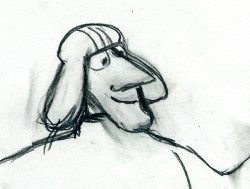 A month into the gig, and I think I’d only spoken with my hero, John, about a half dozen times. I was rushing through one of the Johnny Gent “Spellbinder” sequences. I inked all of his scenes, then inbetweened in ink the drawings. No time to work in pencil for this schedule. Johnny was completely off character, in a very old fashioned way, and I had to rework them all closer to the models – in ink. The schedule just gave me no time to be proud of what was happening. (A year or so later I apologized to Johnny for what I did to his artwork. I was so inexperienced and had such a dominant role in how the final art looked in that series.)
A month into the gig, and I think I’d only spoken with my hero, John, about a half dozen times. I was rushing through one of the Johnny Gent “Spellbinder” sequences. I inked all of his scenes, then inbetweened in ink the drawings. No time to work in pencil for this schedule. Johnny was completely off character, in a very old fashioned way, and I had to rework them all closer to the models – in ink. The schedule just gave me no time to be proud of what was happening. (A year or so later I apologized to Johnny for what I did to his artwork. I was so inexperienced and had such a dominant role in how the final art looked in that series.)
John Hubley ran in to give me something and made a quick comment about the character I’d been drawing. He said it was a “Paramount eye.” I looked at the drawing, then at him. Then John drew on a small piece of paper a “Disney eye,” then a “Terrytoon eye.” He laughed aloud and told me to try to square off the eyes a bit. Then he ran out.
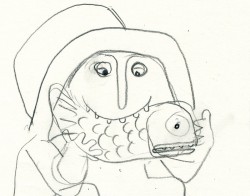 I learned a lot that day. I watched eyes that day and probably all that week. I ran Hubley films at lunchtime (I’d made it a habit to project their films in the kitchen during many of the lunch breaks. The entire group enjoyed these sessions) and watched the eyes. I talked with Tissa David about eyes in one of our evening tutorials – she was trying to teach me how to inbetween properly.
I learned a lot that day. I watched eyes that day and probably all that week. I ran Hubley films at lunchtime (I’d made it a habit to project their films in the kitchen during many of the lunch breaks. The entire group enjoyed these sessions) and watched the eyes. I talked with Tissa David about eyes in one of our evening tutorials – she was trying to teach me how to inbetween properly.
I was reminded of this moment when Chuck Rekow commented on the Moonbird Walk posted weeks ago. “The shape of the eyes on the boys is a real departure from almost anything in the cartoon world —even 50′s era. It’s closer to real life, and reminds me of the graphic style of Ben Shahn. It lends the film an aura of “seriousness”, even though it’s a cute film about two boys and an imaginary bird. Obviously, the pre-recorded sound is a major deal, but this gem is loaded with touches of inventive detail.”
How right he is, and I love being reminded of it.
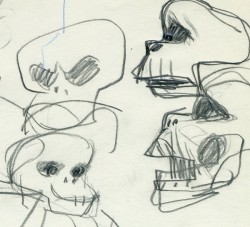 The eyes are the direct route to the soul of a person and, consequently, an animated character as well.
The eyes are the direct route to the soul of a person and, consequently, an animated character as well.
After working for the Hubley studio, for a short bit, I worked for Phil Kimmelman and Associates. This was a hardy commercial studio doing tight designer-based animation. Rowland Wilson was doing a lot of their design work, and the animation clean-up was tight. Animators Jack Schnerk, Sal Faillace and Dante Barbetta did a lot of the work the few months I was there. I worked primarily as an inbetweener and learned some hard and tight lessons while there.
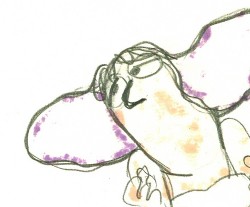 After the very loose work I’d been doing for the Hubley films, it was not only difficult for me, but good to keep me towing the proper line. I wanted to learn animation, and all of it was important.
After the very loose work I’d been doing for the Hubley films, it was not only difficult for me, but good to keep me towing the proper line. I wanted to learn animation, and all of it was important.
Here, too, an empahsis was on the eyes. No Disney eyes, no Hubley eyes, either. But now I was just concerned with keeping those lines tight tight tight. No shimmer on the eyeballs. After all, I was told, people stared into the characters’ eyes, and any flaws in the animation would show up first in those eyes.
I worked for PK&A for about three or four months. I’d also worked for Tubby the Tuba at NYInstitute of Technology under Johnny Gentilella, where we got somewhat close and I was able to discuss all sorts of animation problems with him. That was the only redeeming element, everything else about the studio was wretched. My displeasure ultimately led to my leaving as soon as I could.
Eventually, I was back at the Hubley studio helping to finish up the short Cockaboody.
The tightening of my inbetweening only brought positives to what I could now do for John Hubley’s animation.
To this day, I still watch eyes closely. For some reason, the tighter the lnework, the closer I watch the assistant’s work. The looser the line, the more I watch the design. I prefer watching the design. Often it means eyes that can be easily labelled: Disney, Paramount, or Terrytoons. I suppose today, you’d say: Pixar, Dreamworks or Blue Sky. (And believe me, you can see those differences even in cg.)
The images above are from the following films:
Animation &Hubley &Tissa David 13 Apr 2009 07:43 am
Seeding
-Tissa David animated the entire film for John & Faith Hubley. This short, as I said in previous posts, was done for PBS’ Great American Dream Machine for producer, Elinor Bunin. As Bob Blechman verified, they were given very little money and time to do an 8 min. short. The Hubleys gave life to the short by putting it on the theatrical and festival circuit.
Here’s a rough run cycle Tissa did for the Goddess of Fertility, who goes about inseminating the world with her seed. Tissa adds to its eccentricity with having the low point in the cycle the passing drawing. She comes up as each leg hits the ground.
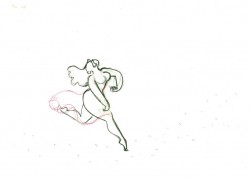 1
1 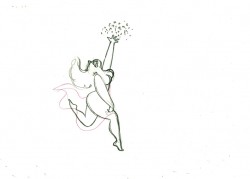 2
a “Goddess” run cycle from Eggs
2
a “Goddess” run cycle from EggsOn threes at 24FPS
Click left side of the black bar to play.
Right side to watch single frame.
Animation &Fleischer &Frame Grabs &walk cycle 09 Apr 2009 08:00 am
Poopdeck Pappy’s walk
I received this delightful note from Borge Ring:
dear michael ♫♫
You sometimes bring stuff on Popeye
There is a Popeye I like very much. It was animated by Bill Nolan in 1940 and the title is Poopdeck Pappy.
I stumbled on this short on internet and realised why Preston Blair had such a high opinion of Nolan.
Blair is quoted by – if I remember right – Charles Solomon in his book.
writes
Børge
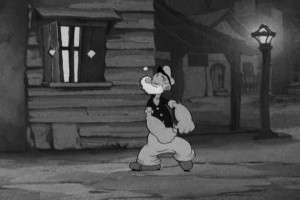 So I ran back to the film (which I know very well.) I’ve made a lot of frame grabs and was going to do a sort of mosaic (without the information that a draft might give me), but it’s taking a lot of time.
So I ran back to the film (which I know very well.) I’ve made a lot of frame grabs and was going to do a sort of mosaic (without the information that a draft might give me), but it’s taking a lot of time.
Consequently, let me make a post of this brilliant walk. There are many of them in this film and lots of hilarious dances. It’s all so balletic and rhythmic. I urge you to listen to Børge, watch the film again. It’s an absolute beauty; this is my favorite period of Fleischer’s work.
Here’s Poopdeck Pappy’s jaunty walk:
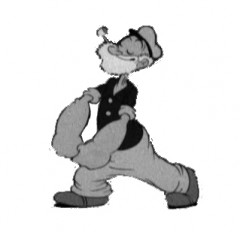 1
1 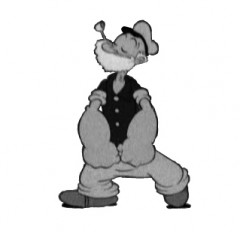 2
Poopdeck Pappy’s walk cycle
2
Poopdeck Pappy’s walk cycleOn ones at 24FPS
Click left side of the black bar to play.
Right side to watch single frame.
Animation &Animation Artifacts &Hubley &walk cycle 07 Apr 2009 07:50 am
Phil Duncan’s walk cycle
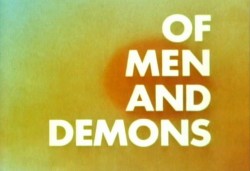 - Phil Duncan was a mainstay of the Hubley animators in all the time I was there.
- Phil Duncan was a mainstay of the Hubley animators in all the time I was there.
You could tell who Hubley’s favorite animators by the frequency in which he doled out sequences to them. Whereas Tissa David or Bill Littlejohn or Barrie Nelson would have been asked to animate entire shorts by themselves, someone like Phil Duncan would get whole sequences to animate. At the same time, John so depended on Phil and trusted what he did.
There were never pencil tests at the Hubley studio. Only one instance of it do I remember, and that was on the Art Babbitt mime scenes from Carousel. As I said once before, I remember John running out to get me asking if I’d like to see animation as good as I’d ever see. We then watched the PT over and over together. Ultimately John took Art’s animation on twos and had me put it on four frame dissolves to get more screen time out of it. A budget was a budget and you had to make the most out of the excellence you had in your hand.
But as I mentioned yesterday, Phil would animate on odd numbers expecting the even numbers to be inbetweened. Most times, John asked me to reexpose the scene on fours and not do the inbetweens. Of course, Phil was aware this would happen and had planned on it.
.
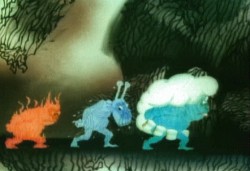
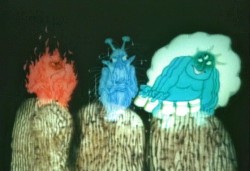
Here is a walk cycle (and more) by Phil Duncan from Of Men and Demons, which was nominated for the Oscar in 1969. The full scene includes the three demons walking and then flying up to their cave.
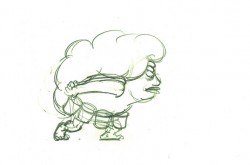 1
1 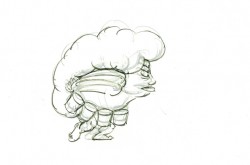 2
2
(Click any image to enlarge to full animation paper view.)
The rest of the scene breaks out of the walk cycle. I
enlarged the frames to accomodate the remainder of the action.
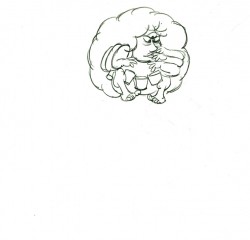 23
23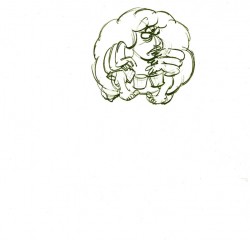 24
24
On threes at 24FPS
Click left side of the black bar to play.
Right side to watch single frame.
Animation &Animation Artifacts &Hubley 06 Apr 2009 07:31 am
Phil Duncan’s Carousel
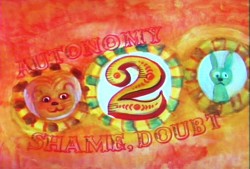 - There’s an odd conversation going on at the Animation Guild Blog. It started out with the traditional CG vs hand drawn argument, then it morphed into who get the better salaries and the greater recognition.
- There’s an odd conversation going on at the Animation Guild Blog. It started out with the traditional CG vs hand drawn argument, then it morphed into who get the better salaries and the greater recognition.
Quite a few brilliant animators passed under the limelight and never got quite the credit they deserved for their long and dedicated work in the medium.
Phil Duncan certainly belongs in this
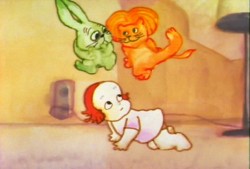 category. I never got to meet him while working at the Hubley studio, but I assisted many of his scenes, spoke with him and came to know his style well.
category. I never got to meet him while working at the Hubley studio, but I assisted many of his scenes, spoke with him and came to know his style well.
He worked for many years animating at the Disney studio, starting on Pinocchio and working his way up into the early 60s. He animated on Magoo’s 1001 Arabian Nights and Gay Purr-ee for UPA.
His work for Hubley began with The Cruise in
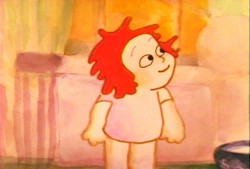 1966 and continued through many of the important films right up to John’s death in 1977. Phil’s work on Watership Down began with John Hubley and continued with Martin Rosen.
1966 and continued through many of the important films right up to John’s death in 1977. Phil’s work on Watership Down began with John Hubley and continued with Martin Rosen.
I got to assist many a scene Phil animated for shorts, commercials, Electric Company spots etc. I also followed him through many scenes on the feature, Everybody Rides The Carousel.
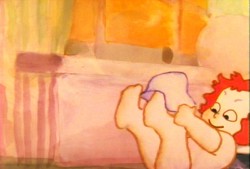
His style was so different from all the other animators I mentioned that it was a delight for me to work behind him. His line was always this great feminine stroke that featured plenty of arcs and curves. He usually left only one inbetween between drawings, and he knew that often enough John Hubley would say to put the scene on fours and not inbetween it. I remember breaking the news to Phil the first time I saw this happen. There was an ever-so-slight downturn in his voice, but it was obvious that he expected this to happen.
Believe me, he wasn’t the only animator who heard me break this news. The films were done on such a tight budget that every penny counted. It did give me some power, because I would judge the scenes to see if I felt there was any point that we couldn’t get away with it, and if that were the case I would inbetween it while inking the drawings. John didn’t need to know, and I worked quickly enough so that it didn’t cost him much more of my salary.
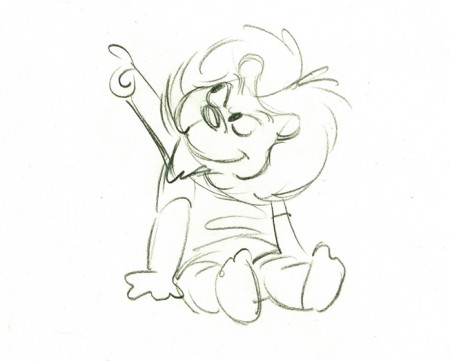 57A
57A(Click any image to enlarge.)
Here are some drawings Phil did for the Toddler sequence from Everybody Rides the Carousel. Horse #2. The toddler can turn into a rabbit (meek) or a lion (daring.) Here she turns into a lion as she tries to dress herself with some help from her mother.
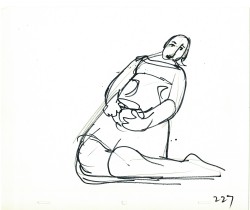
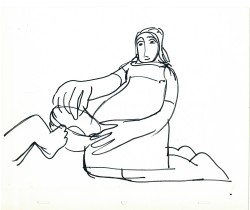
These are a couple of layouts by John Hubley.
Below, is a clean up that he sent to Phil Duncan of the mother’s head.
Here’s the next scene’s animation before it underwent some changes.
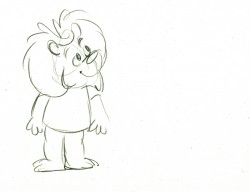 13
13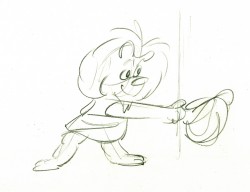 17
17
As you’ll notice from the frame grabs above, this sequence changed.
John wanted to go with the girl whose head, for a brief moment,
turns into the lion’s head. (Doubt) I did the change using most of
what Phil had on his original drawings.
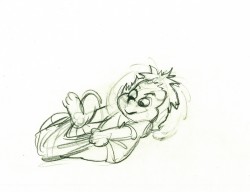 35
35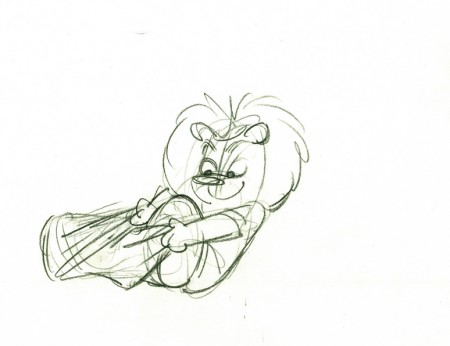 37
37
Note that on her hit down onto the floor #35, she turns back
into the toddler child before going back to the aggressive lion.
Animation &Animation Artifacts &Hubley &walk cycle 30 Mar 2009 07:56 am
Marky’s Walk
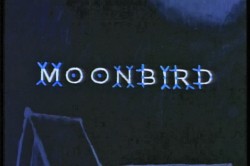 - If I had to choose who was my favorite animator, I’d have a tough time. Equal credit would probably have to go to three different people: Bobe Cannon, Tissa David and Bill Tytla. Jim Tyer and Ed Smith would fall just a smidgen below these three, for me. But there are none like them all, as far as I’m concerned.
- If I had to choose who was my favorite animator, I’d have a tough time. Equal credit would probably have to go to three different people: Bobe Cannon, Tissa David and Bill Tytla. Jim Tyer and Ed Smith would fall just a smidgen below these three, for me. But there are none like them all, as far as I’m concerned.
I’ve posted a lot of drawings from Tissa and Bill Tytla, but have very few drawings by Bobe Cannon (nor have I seen many published anywhere.)
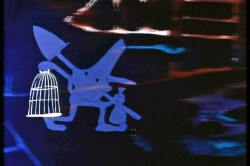 Here is a walk cycle from the beginning of Hubley’s monumental short, Moonbird. The odd numbers are extremes by Cannon, and the inbetweens (even numbers) were done by Ed Smith. Three different sized papers were used for this, and you can view them full sized if you click the thumbnails.
Here is a walk cycle from the beginning of Hubley’s monumental short, Moonbird. The odd numbers are extremes by Cannon, and the inbetweens (even numbers) were done by Ed Smith. Three different sized papers were used for this, and you can view them full sized if you click the thumbnails.
You’ll notice there’s paint all over the drawings. The ink & paint involved tracing the drawing, then using oil paints to cover all of the clear area in black. Some of that paint seeped onto the originals. In one drawing even to coloring the hat accidentally.
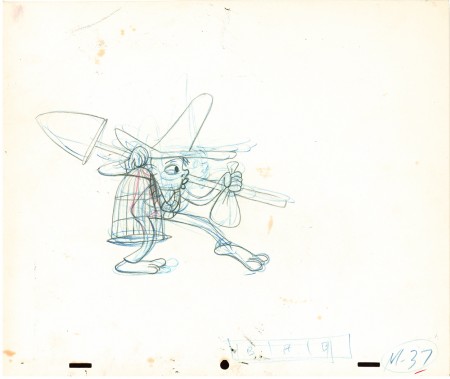 37
37(Click any image to enlarge.) “Marky” walk cycle from Moonbird
On twos at 24FPS
Click left side of the black bar to play.
Right side to watch single frame.
There’s a lot more to this scene including several variants on the walk.
At some future time, I’ll add the other drawings to show off the entire scene.
Animation &Animation Artifacts &Fleischer &Models &walk cycle 23 Mar 2009 07:59 am
Wiffle Piffle
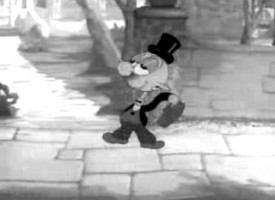 - Wifle Piffle was a character that the Fleischer studio tried to develop out of the Betty Boop series. The first appearance was in a Screen Song: I Feel Like A Feather In The Breeze released in 1936. He appears as a waiter in the opening. The animation of the character was by Tom Johnson (as was this model sheet.)
- Wifle Piffle was a character that the Fleischer studio tried to develop out of the Betty Boop series. The first appearance was in a Screen Song: I Feel Like A Feather In The Breeze released in 1936. He appears as a waiter in the opening. The animation of the character was by Tom Johnson (as was this model sheet.)
Two follow-up films were made with this side character in Betty Boop shorts.
The first, released in February 1937, was Whoops! I’m A Cowboy, and the second, in March 1937, The Hot Air Salesman. The opening scene features an expensive multiplane shot behind him.
He seems to have been an Egghead type character whose sole character trait was a silly walk. Needless to say, they couldn’t find a joh for him.
The model sheet for the character was an 18 drawing walk cycle with a bit of a turnaround. Crosshairs keep the character in registration; only a couple of the pages were punched.
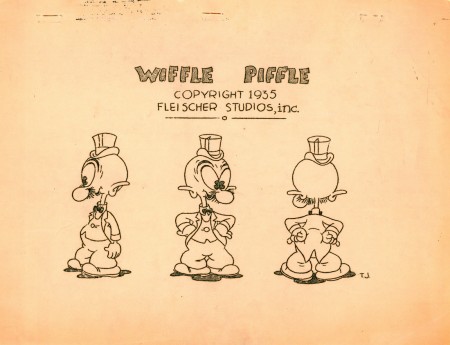 Wiffle Piffle walk cycle
Wiffle Piffle walk cycleOn ones at 24FPS
Click left side of black bar to play.
Right side to watch single frame.
Animation &Animation Artifacts &Tissa David &walk cycle 16 Mar 2009 07:43 am
More Mt. Dew
- Last week I posted some animation drawings done by Grim Natwick which he animated in a spot for Mountain Dew. The drawings I posted were actually the assistant’s drawings done by Tissa David. The spot was produced by Robert Lawrence Productions.
This is another run cycle from that same film. Again, all of the drawings, here, are Tissa’s clean-ups.
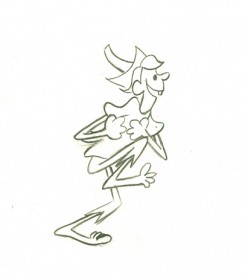 1
1 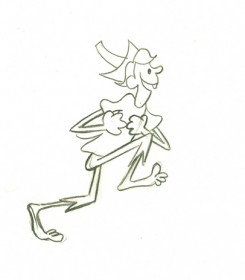 2
2(Click any image to enlarge to actual animation sized drawing.)
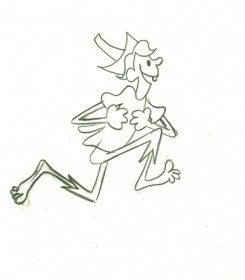 3
3 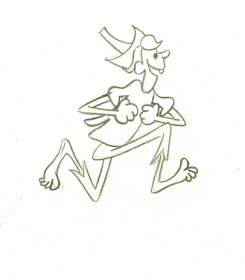 4
4
You’ll note that the character leaves the ground for 1/3 of the spot.
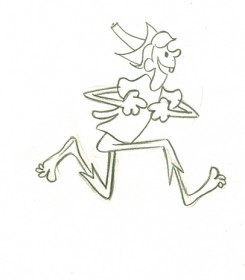 5
5 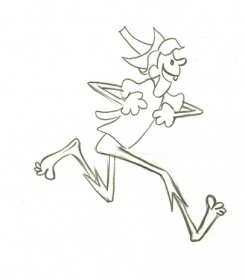 6
6
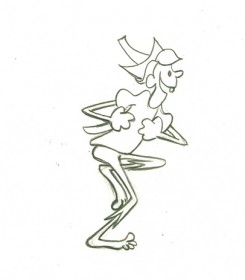 9
9 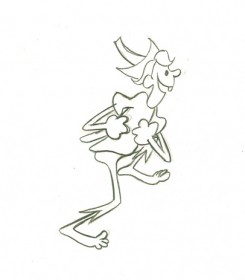 10
10
He actually comes down in the crossing position rather than the
classically designed walk where the head moves up.
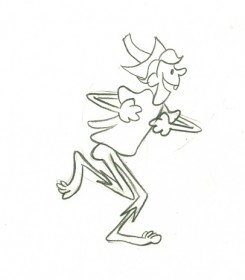 17
17 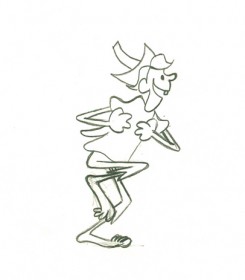 18
18
Tissa’s tnedency is to have the crossing position the lowest in the cycle.
The character bears the weight of his walk with feet solidly on ground.
On ones at 24FPS
Click left side of black bar to play.
Right side to watch single frame.
Animation &Animation Artifacts 12 Mar 2009 07:58 am
Taras & Fritz
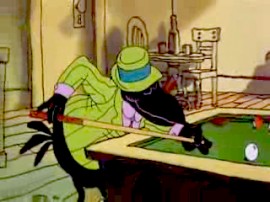 - Reading a short piece about Ralph Bakshi on David Levy’s Animondays blog, brought me back to my collection of drawings. Here are some drawings from Fritz the Cat, the first scene of the pool sequence.
- Reading a short piece about Ralph Bakshi on David Levy’s Animondays blog, brought me back to my collection of drawings. Here are some drawings from Fritz the Cat, the first scene of the pool sequence.
The drawings are by New York staple, Marty Taras. He, Johnny Gentilella and Nick Tafuri all had similar drawing styles. The clean rough. An inker could (and did at Hubley’s) work directly from their drawing without a cleanup by and an Assistant. These drawings were assisted by Jim Logan, who gave the drawings to me back in 1976.
(Johnny was an amazingly sweet guy, who spent a lot of time teaching me much in those early days. Marty was someone whose defenses always seemed to be up. Perhaps this is the reason he was the brunt of som many gags back at Terrytoons. Nick, when I knew him, was grumpy. He seemed not very talkative – just wanted to hand in the job and get outta there. But he did a couple of the best takes I’ve ever seen in the animation he handed in.)
Marty’s style was to work so light that it’s a struggle to see the red lines. For these scans, I had to darken the artwork so that the paper ends up with a bit more yellow than it has in reality.
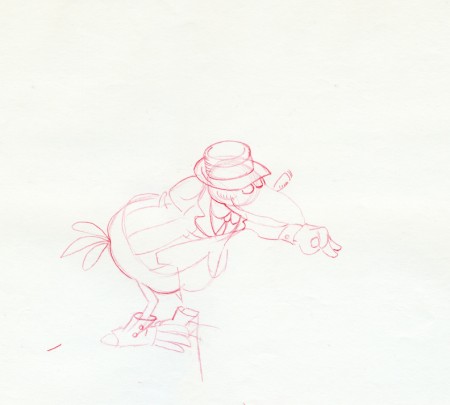
The crow chats with Fritz.
His arm and pool cue are on another level.
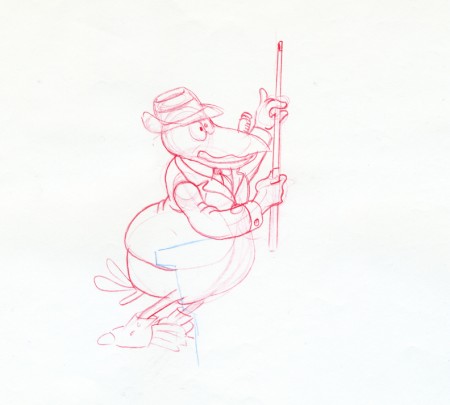
(Click drawings for enlarged versions of the entire animation sheet.)
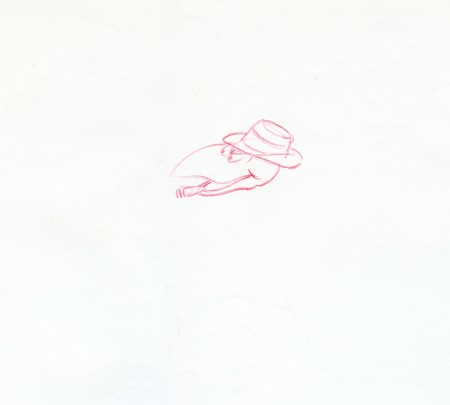
Crow’s head moves to a separate level as he chats with Fritz.
